Howarth Family
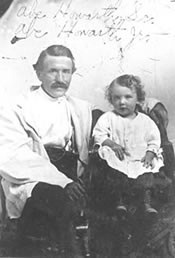
Abraham Howarth Sr., and Abe Jr. c.1870-71.
Englishman Abraham Howarth, a cotton grower, his wife Alice Barlow and baby Abe decided to immigrate to America. After arriving in Colorado in the late 1860's, they purchased a farm on Plum Creek close to where Chatfield Dam is located today. The purchase of 390 acres made it possible for Abraham to raise cattle and hogs, as well as farm corn, barley and oats. Abraham was involved in business enterprises in addition to ranching and he helped form the First National Bank in Littleton. In fact, he served as vice-president and director of the bank beginning in 1909.
Abraham and Alice had two daughters, Sarah and Alice, to join son Abe Jr. Abe Jr. grew up and married Carrie Body, whose family lived north of Denver. Abe Jr. and Carrie had five children, three girls and two boys: Helen (1906), Evelyn (1908), Elizabeth (1910), Bill (1912) and Carl. The boys showed an early interest in raising and caring for animals. At the age of six, Bill began the enterprise of milking shorthorn cattle and selling the cream to Denver butter makers. The skim milk was fed to the hogs and calves.
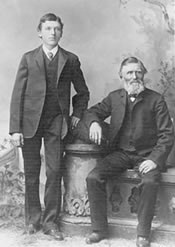
Abraham Howarth Sr., and Abe Jr. c.1880.
In 1919, the family moved into Littleton so the children could attend schools in town. They bought a new farm at 3563 Bowles and continued to work the acreage at Plum Creek. Bill lettered in football while attending Grant Street School and graduated in 1930. Mrs. Abe Howarth, Carrie, was involved in local charity work. She cooked food to distribute to homeless families and in 1936, she was selected Foremost Mother of the Year by the Littleton Independent.
Carl wanted to be a veterinarian while Bill hoped to become a medical doctor. Carl began college at Colorado State University and was able to complete his degree in veterinary medicine in 1935. Bill attended the University of Colorado in Boulder. However, the Howarths lost their life savings in January, 1933 when the First National Bank of Littleton closed. Bill dropped out of school to help support the family. For several years Bill worked as a farmer on the Plum Creek Ranch and also at John Schley's farm nearby. He also leased and operated a Conoco gas station at Main and Rapp Streets in Littleton. The station turned profitable, but Bill didn't lose track of his long-term goal of completing college. By 1937 he had saved enough money to return to college. Bill attended the Colorado State University veterinary school in Fort Collins beginning in 1937. He graduated in 1942 as a doctor of veterinary medicine.
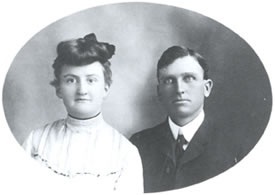
Mr. Abe Howarth Jr. and Mrs. (Carrie) Howarth, c.1900.
For six months Bill practiced veterinary medicine in Prescott, Arizona, before Colorado State University offered him a position. He returned to Fort Collins for a while, taking students to the farms to treat sheep, cattle, horses and hogs. At this time, World War II was raging and more soldiers were needed. Bill enlisted as a private in the Army in 1943. In short order, with his credentials recognized, he was made an officer and began working with the ski troops at Camp Hale, Colorado. Bill also served in India and Burma treating wounded pack animals as a captain in the Army Veterinary Corps.
Littleton had a veterinarian during the war, Dr. Spratlin, so there was really no need for another veterinarian. But shortly after the war ended, Dr. Spratlin was killed in a car accident. Several residents urged Bill Howarth to return to Littleton to work. After he was discharged from the army, Bill established a veterinary medicine practice in 1946 at 5000 S. Santa Fe Drive in Littleton.
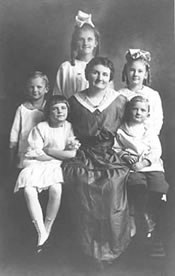
Family of Abe Howarth Jr., c. 1918. Carrie Marie Body Howarth (mother, center), and clockwise from lower left: Elizabeth, William A., Helen, Evelyn, and Carl.
Initially Bill worked with large animals, but soon residents began bringing their small animals, cats, dogs, birds, etc. He built a veterinary hospital on Santa Fe Drive in the late 1940s. In 1950, while treating a horse, an accident left him with a severe back injury and he was forced to limit his practice to small animals. A popular vet, he worked hard to build up his practice, and was chosen Colorado Veterinarian of the Year in 1967. Bill gave up his hospital in 1986 to the Colorado State Highway Department for the widening of Santa Fe Drive.
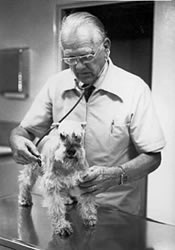
Dr. William A. Howarth operated the Howarth Animal Hospital at 5000 S. Santa Fe Drive since 1946. c.late 1980s.
Bill married Hilma Thulin, a childhood friend, on July 27, 1946, about the same time as he began his practice in Littleton. He was a member of the Rotarians beginning in 1948 and served as its president in 1962-3. He also served as president of the Denver Area Veterinary Association and headed the American Animal Hospital Association.
For a hobby, Bill Howarth, together with his friend Bill Gunesch, conducted horticulture experiments on the Howarth Farm. There, Howarth's main activity was growing oak trees from seedlings, but he also raised a few cattle and crops. In 1995, he conveyed his tree farm to a charitable trust and established the William A. Howarth Scholarship Fund for the Colorado State University Veterinary Medicine and Biological Science Department. The oak trees were also donated to CSU and planted on the campus. The Howarth farmland was purchased by American West Homes and a housing subdivision, named Howarth Farm, was developed.
Bibliography
Littleton (Colo.) Independent. The Littleton Independent Publishers, 1888-.
Littleton Museum, Oral History Collection, "Dr. William Howarth, DVM." March 20, 1987.
Littleton Museum. Vertical File. Biography: Howarth.
Photographs courtesy of the Littleton Museum unless otherwise noted. To order copies, contact the museum at 303-795-3950.
Compiled by Rebecca Dorward
Edited by Phyllis Larison and Lorena Donohue
Updated March 2021 by Phyllis Larison